Ford Sierra
The Ford Sierra is a mid-size car or large family car that was built by Ford Europe from 1982 to 1993. It was designed by Uwe Bahnsen, Robert Lutz and Patrick le Quément. The code used during development was "Project Toni".[3] Its name came from the Spanish word for mountain range.
| Ford Sierra | |
|---|---|
 | |
| Overview | |
| Manufacturer | Ford Europe |
| Also called | Merkur XR4Ti (North America, 1985-1989) Ford Sapphire (South Africa, 1990-1993) |
| Production | 1982–1993 |
| Assembly |
|
| Body and chassis | |
| Class | Mid-size car/Large family car (D) |
| Body style | 3-door liftback 5-door liftback 4-door saloon 5-door estate 5-door car derived van |
| Layout | Front-engine, rear-wheel drive / four-wheel drive |
| Related | Ford Scorpio Ford P100 Merkur XR4Ti |
| Powertrain | |
| Engine |
|
| Transmission | 3-speed automatic 4-speed automatic 4-speed manual 5-speed manual |
| Dimensions | |
| Wheelbase | 102.7 in (2,609 mm) |
| Length | 178.4 in (4,531 mm) |
| Width | 68 in (1,727 mm) |
| Height | 53.8 in (1,367 mm) |
| Chronology | |
| Predecessor | Ford Cortina Mark V Ford Taunus TC3 |
| Successor | Ford Mondeo |
The Ford Sierra was first unveiled on 22 September 1982 at the British International Motor Show hosted at the NEC in Birmingham.[3] with sales beginning on 15 October 1982,[4] replacing the Ford Cortina. Its aerodynamic styling was ahead of its time and as such, many conservative buyers (including company car drivers) did not take fondly to the Cortina's replacement.[3]
It was mainly manufactured in Germany, Belgium, and the United Kingdom, although Sierras were also assembled in Ireland, Argentina, Venezuela, South Africa and New Zealand.
Versions
| Photograph | Version | Built from | Built until |
|---|---|---|---|
 | Ford Sierra (Mk I) | 1982 | 1987 |
 | Ford Sierra (Mk II) | 1987 | 1990 |
 | Ford Sierra (Mk II facelifted) | 1990 | 1993 |
Initial development and reception
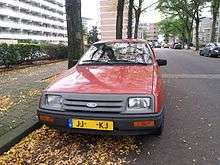
.jpg)
.jpg)
By 1978, Ford Europe was working on a new mid-range model to replace the Cortina/Taunus during the early 1980s, working under the codename "Project Toni".
Ford had confirmed during 1981, a year before the Sierra's official launch, that its new mid-range car would carry the Sierra name, signalling the end of the Cortina nameplate after 20 years and five generations. In September that year, it had unveiled the Probe III concept car at the Frankfurt Motor Show, hinting at what the new car would look like when the final product was unveiled 12 months later.
At first, many found the design blob-like and difficult to accept after being used to the sharp-edged, straight-line styling of the Cortina, and it was nicknamed "the jellymould".[5] The shape served a purpose though, producing a drag coefficient of 0.34, a significant improvement over the boxy outgoing Cortina's 0.45.[6] The interior was more conventional, although Ford took a page from BMW by angling the center of the dashboard towards the driver.[7]
Sales were slow in the first months - the situation being exacerbated by heavy discounting by Ford dealers of surplus Cortina stock from the autumn of 1982 onwards, with more than 11,000 new Cortinas being registered in 1983. However in 1983, its first full year of sales, the Sierra managed nearly 160,000 sales in Britain, outsold only by the smaller Escort. Ford had also launched the more conservatively designed Escort-based Orion saloon that year, which found favour with buyers who would otherwise have been the Sierra's target customers.[8]
In West Germany, it was proving very popular from an early stage; within months of its launch, it was reportedly achieving treble the number of sales that the Taunus had been attaining - though in West Germany, the Taunus had not been quite as popular or iconic as its Cortina equivalent had been in Britain.[9]
It was later in the Sierra's life that the styling began to pay off; ten years after its introduction, the Sierra's styling was not nearly as outdated as its contemporaries, even though all major competitors were newer designs, though the Sierra had been tweaked on several occasions and many new engines had been added. The most notable changes came at the autumn of 1987, with a major facelift and the addition of a 4-door saloon (UK: Sapphire). As other manufacturers adopted similar aerodynamic styling, the Sierra looked more normal. At its peak, it was Britain's second best selling car in 1983, 1988 and 1989, and was still Britain's fifth best selling car in 1992. Its best year was 1989, when more than 175,000 were sold. However, it was outsold by the Vauxhall Cavalier in MK2 form during 1984 and 1985, and then from 1990 until its demise by the MK3 Cavalier. Nevertheless, it comfortably outsold its second key rival, the Austin Montego, which was launched in April 1984. Between 1985 and 1988, the Sierra faced fresh competition in Europe from the likes of the Renault 21 and Peugeot 405, while Japanese carmaker Nissan was producing its Bluebird model in Britain from 1986.
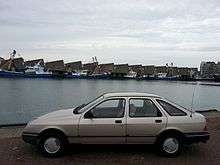
Early versions suffered from crosswind stability problems, which were addressed in 1985 with the addition of "strakes" (small spoilers) on the rear edge of the rubber seals of the rear-most side windows. These shortcomings saw a lot of press attention, and contributed to early slow sales, when it was outsold by its key rival the Vauxhall Cavalier in 1984 and 1985. Other rumours that the car hid major crash damage (in part true, as the new bumper design sprung back after minor impact and couldn't be "read" to interpret major damage) also harmed the car's reputation. This reached near-hysterical heights in its early months on sale, with UK press making a report that Ford would reintroduce the previous Cortina model out of desperation. These reports were swiftly denied by Ford. However, sales began to rise during 1983, and it finished as Britain's second best selling car behind the Escort. After being outsold by the Cavalier for the next two years, it regained its lead of the market sector in Britain during 1986, and a refreshed range (with more engine options as well as the introduction of a saloon) enjoyed a surge in sales from 1987, though the MK3 Cavalier finally outsold it in 1990. Even in 1992, the Sierra was still Britain's fifth best selling car. It was nicknamed "the salesman's spaceship" on account of its status as a popular fleet car in Britain.[10]
Additionally, earlier models used the 1.3, 1.6 and 2.0 litre versions of the Pinto engine (as used in the Ford Cortina) paired with a four- or five speed manual gearbox. At a time when the rival Vauxhall Cavalier was offered with a five-speed, this led to some critics commenting that the Sierra was somewhat underpowered. In the mid-1980s, many smaller cars (some even two segments smaller) featured five-speed gearboxes.
At its launch, some of the Sierra's external styling differed depending on the specification. In place of the model's regular two-bar grille, which was unpainted on the lowest-specification model, the Ghia featured a narrower blanked-off grille between wider, but still inset headlights, while the front bumper was also restyled and featured combined indicator/foglight units compared to the lower-spec model's slimmer but wider indicator units. The XR4i had an identical front end to the Ghia, bar the bumper which was slightly different. The rear lights of the Ghia were the same shape and layout as other models, but featured tiny horizontal strakes on the lenses to give the impression that they were smoked. For the 1985 model year, all the lower-spec models, except the base model, adopted the Ghia and XR4i's front grille and headlight treatment.
The car was replaced by the Mondeo in Europe in March 1993, though stocks lasted for about two years afterwards. The Sierra remained a popular second-hand buy and common sight on British roads until well beyond the year 2000.
Press evaluation
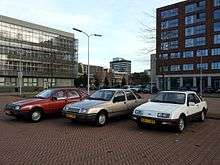
In Europe's largest auto-market, the magazine Auto, Motor und Sport published, in December 1982, a three-way road test comparison involving the Sierra and its obvious competitors, the recently upgraded Volkswagen Passat and Opel Ascona (Vauxhall Cavalier Mk II in the UK). Then as now, a part of the magazine's comparison road test report was a comparison chart rating each of approximately 100 attributes of cars tested out of ten or twenty points (according to importance) and then ranking the cars tested according to the total number of points awarded. On this basis the Sierra tested in 1982 outranked both the Passat and the Ascona.
The significance of this result was highlighted more than three decades later, in February 2015, when the magazine reported that no Ford model had beaten a Volkswagen under their road test criteria since the Sierra's "victory" in 1982.[11]
The Sierra missed out on the European Car of the Year award, which instead went to the Audi 100.[12]
Celebrity
Just before he became leader of the Labour Party in 1983, Neil Kinnock became the owner of one of the first Sierras produced for the British market, but his car was wrecked in a crash on the M4 motorway in Berkshire soon after he bought it. He escaped from the crash uninjured.[13]
Manufacture
It was mainly manufactured in Germany, Belgium, and the United Kingdom, although Sierras were also assembled in Ireland,[14] Argentina, Venezuela, South Africa and New Zealand.
All-wheel drive
In 1985, at the Geneva Motor Show, the four-wheel drive Sierra XR4x4 was shown as a derivative of the XR4i. It had two viscous differentials with two thirds of the power directed towards the rear wheels. It was originally available only as a three-door hatchback; the bodywork had the large single-piece rear windows rather than the design with an additional pillar as used on the XR4.[15] The XR4x4 had a single rear spoiler instead of the distinctive biplane unit used on the XR4 but did receive unique alloy wheels.[16] A five-door version was added soon thereafter. A four-wheel-drive estate became available with this drivetrain at the 1986 Geneva Motor Show, but with Ghia rather than XR4x4 badging.[17] This version was better equipped and without the sporting edge of the hatchbacks, and was also available with an automatic transmission.[18][19] The four-wheel drive allowed for an extra margin of security on slick or snowy roads, while retaining the car's rear-wheel drive comportment.[16]
The original, rear-wheel drive XR4 was quickly taken out of production after the XR4x4 arrived. The XR4x4 originally came equipped with the 2.8 litre Cologne V6 engine using the same Bosch K-Jetronic mechanical injection system used since 1977 in the Granada, and since 1981 in the Capri, but it was replaced in 1989 by the new more efficient 2.9 litre Cologne V6 engine, with Electronic fuel injection.
1987 facelift
In September 1987, a restyled Sierra was launched for the 1988 model year and a four-door saloon version was added to the range - this was marketed as the Sierra Sapphire on the UK market. The front end was completely revised, with the biggest difference seeing the indicators now positioned above the bumper and to the side of a new headlight design. While the grille again remained blanked-off, UK, Irish and South African versions of the newly introduced saloon bodystyle, featured a unique shallow black grille between the headlights. That apart, all specifications of the Sierra now shared a common front end, compared to the car's original styling. The side windows were made slightly larger with the corners made sharper to increase outward vision. The rear lights were replaced with slimmer but wider models containing separate stop lamps. The saloon got similar rear lights as the revised hatchbacks, though not interchangeable. The rear end of the estate has never changed during the Sierra's lifespan. The interior was slightly modernized.
Also new to the range was a new 1.8 litre "lean burn" petrol engine, which proved to be one of the most popular choices in the Sierra range.
The XR4x4 was now based on the five-door hatchback bodystyle and featured different front and rear body-coloured bumper styling, along with wider side rubbing strips. The RS Cosworth, from January 1988, was now based on the newly introduced saloon bodystyle and featured another style of front bumper as well as the black grille which was only found on UK versions of the saloon bodystyle. The RS Cosworth received more power and four-wheel drive from January 1990. In addition, a roller cam engine was added in 1987 to prevent excessive wear to the cam.
From 1988 a pickup called the P100 was produced in Portugal using the Sierra-cab and engines, replacing the previous Cortina/Taunus-related model.
The Sierra was Ford's answer to the success of the General Motors "J-car" (Vauxhall Cavalier in the UK), which had been launched in 1981 with front-wheel drive and a hatchback bodystyle to complement the saloon. Unusually in its sector by that time, the Sierra was still rear-wheel drive.
It was also a strong competitor for other rivals of the early 1980s, including the Talbot Alpine, Peugeot 505 and Morris Ital and the Citroën BX, but by 1988, it was competing with a host of new rivals, including the third generation Vauxhall Cavalier (Opel Vectra), Rover Montego, Peugeot 405, Renault 21 and Nissan Bluebird.
Bodystyles
The switch to the Sierra from the Cortina and Taunus was the second time that Ford had changed its saloon-based line-up into a hatchback-based one following the launch of the Escort Mark III in 1980, and before the introduction of the Scorpio (known as the Granada Mark III in the UK and Ireland) in 1985. However, like the Cortina and Taunus before it, the Sierra was available as an estate.
The company launched the Ford Orion in 1983 to fill the gap in the saloon range left by the Cortina. Ford found that customers were more attached to the idea of a saloon than they had expected, and this was further addressed in 1987 by the production of a saloon version of the Sierra. In the UK, this model was called the Ford Sierra Sapphire. This differed from the other Sierra models in having a traditional black grille, which only appeared in right hand drive markets.
During the life of the car, two different styles of 3-door body were used; one with two pillars rear of the door, looking very much like a modified 5-door frame, as used on the high-performance XR4i; and a one-pillar design used on standard-performance 3-door hatchbacks and also at the other end of the scale as the basis for the very high-performance RS Cosworth.
At the time of the car's launch, both styles were already envisaged, and a demonstration model with one style on either side was displayed at a Sierra design exhibition at the Victoria and Albert Museum in London, but the one-pillar design was not launched until 1984. The 3-door Sierra was later dropped in the UK, although the Cosworth version continued. Production of the 3-door Sierra continued in continental Europe, including after the Sierra range was given a facelift in 1987, but this was never offered in the UK.
A 5-door van based on the estate, known as the Sierra Van, was introduced in 1984, which, unlike similar car-derived vans, retained its side windows.[20] The back seat was removed and the metal cargo floor was extended towards the front seats.[21] A diesel engine and a limited choice of petrol engines were available for the Van. This variant was never sold in the UK. although some were produced in right hand drive for the Irish market.[22]
- Ford Sierra estate, with original aero design, and front panel of higher-specification models
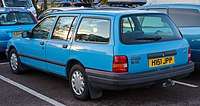 1991 Ford Sierra LX Estate 1.8 (United Kingdom)
1991 Ford Sierra LX Estate 1.8 (United Kingdom).jpg) 1989 Ford Sierra Sapphire GLS, with earlier red/white/amber rear lights (United Kingdom)
1989 Ford Sierra Sapphire GLS, with earlier red/white/amber rear lights (United Kingdom).jpg) 1991 Ford Sierra Sapphire 2.0 Ghia Automatic, showing the smoked rear lights in use from 1990-1993 (United Kingdom)
1991 Ford Sierra Sapphire 2.0 Ghia Automatic, showing the smoked rear lights in use from 1990-1993 (United Kingdom)
Sierra model range
Drivetrain options
During its career, the Sierra was available with a wide range of petrol engines:
- 1.3 I4 OHC (1294 cc; 60 PS (44 kW; 59 hp)) Pinto engine;
- 1.6 I4 OHC (1593 cc; 75 PS (55 kW; 74 hp)) Pinto engine, available in standard or economy tune;
- 1.8 I4 OHC (1796 cc; 90 PS (66 kW; 89 hp)) Pinto engine (from 1985);
- 1.8 I4 OHC (1796 cc; 80 PS (59 kW; 79 hp)) CVH Engine (from 1989);
- 2.0 I4 OHC (1998 cc; 105 PS (77 kW; 104 hp)) Pinto engine;
- 2.0i I4 OHC (1993 cc; 115 PS (85 kW; 113 hp)) Pinto engine with fuel injection (from 1985);
- 2.0i I4 DOHC (1998 cc; 125 PS (92 kW; 123 hp)) DOHC engine (from 1989);
- 2.0i I4 DOHC 16V Turbo (1993 cc; 204 PS (150 kW; 201 hp)) DOHC engine, YB Turbo (RS Cosworth, 1986-1987);
- 2.0i I4 DOHC 16V Turbo (1993 cc; 225 PS (165 kW; 222 hp)) DOHC engine, YB Turbo (RS500 Cosworth, 1987);
- 2.0 V6 (1999 cc; 90 PS (66 kW; 89 hp)) Cologne V6 engine;
- 2.3 V6 (2294 cc; 114 PS (84 kW; 112 hp)) Cologne V6 engine;
- 2.8i V6 (2792 cc; 150 PS (110 kW; 148 hp)) Cologne V6 engine (XR4i, 1983-1985, XR4x4 1985-1987)
- 2.9i V6 (2935 cc; 150 PS (110 kW; 148 hp)) Cologne V6 engine (XR4x4, from 1987)
Two diesel engines were available:
- 2.3 I4 D (2304 cc, 67 PS (49 kW; 66 hp)) Peugeot Diesel engine (1982-1990);
- 1.8 I4 TD (1753 cc; 75 PS (55 kW; 74 hp)) Endura-D engine (from 1990)
1300, 1600 and 2000 engines all had a 4-speed manual gearbox; a 5-speed manual gearbox was optional with 1600 and 2000 engines, and standard with the 1600 Economy engine, the 2300 and 2300 Diesel. An optional 3-speed automatic transmission was available with 1600, 2000 and 2300 engines.
The 2.0 V6 and 2.3 V6 versions of the Sierra were dropped at the end of 1985 and the 1.3 was discontinued in 1986. A carburetted 1.8 and a fuel injected 2.0-litre petrol engine were added at Geneva 1985.[23] In 1990, the 2.3 diesel was replaced by a 1.8 turbodiesel. The turbocharged 2.0 RS Cosworth engine featured on all three Cosworth versions of the Sierra; the three-door rear-wheel drive hatchback, the rear-wheel drive saloon, and the four-wheel drive saloon.
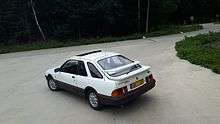
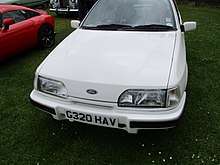
The sporting model XR4i utilized the 2.8 engine with mechanical fuel injection (Bosch K Jetronic) coupled to rear-wheel drive (1983-1985) and to four-wheel-drive as XR4x4 (1985-1987). There was also a 2.8-engined Ghia Estate in some markets, and from 1985 until 1987 Swiss customers could buy rear-wheel-drive, 2.8-powered GL and Ghia models with five-door hatchback or estate bodywork.[24] The Swiss (and Swedish) market engines produced marginally less power, as those countries had particularly stringent emissions standards. Output was 148 PS (109 kW) in 1985 and 145 PS (107 kW) in 1986.[17][24] In the Mark II Sierras the 2.8 Cologne engine was replaced by a 2.9-litre version. Both the 2.8/2.9-litre engines gave 150 PS in uncatalyzed trim.
The well known Cosworth model was powered by a turbocharged 16-valve 4-cylinder engine known as the YB which was based on the Ford Pinto block. The Ford Sierra RS Cosworth was introduced in 1986 as a three-door hatchback, with a 2-litre DOHC turbo engine producing 204 PS (150 kW; 201 hp) and a top speed of 150 mph - a speed normally found only in sports cars from prestige brands like Ferrari and Porsche, at much higher prices as well as with less practicality. At the time Ford wanted to compete in group A touring cars and therefore eligible to produce a limited run of 10% of the initial production, therefore this would be 500 cars. this was known as an 'evolution' model. Ford employed Tickford to help with the development. The Sierra RS500 as it was known sported a small additional rear spoiler, and larger front chin spoiler, extra cooling ducts for the engine, brakes and intercooler. Under the bonnet a larger turbo and intercooler was fitted along with an extra set of injectors, so instead of the standard four injectors it was built with eight, although in road trim these extra injectors did not function. These modifications produced 225 PS (165 kW; 222 hp) in road trim and around 550 hp (410 kW) in race trim. They were very successful in motorsport and are highly tunable road cars with a very large following.
In 1987, Ford introduced a four-door saloon (marketed in the UK as the Sierra Sapphire), which was sold alongside the hatchback and estate until the Sierra was replaced by the Mondeo in early 1993. The last Sierra rolled off the production line in December 1992.
The Sierra Cosworth switched to a saloon bodystyle in January 1988, again with rear-wheel drive, before the four-wheel drive version replaced it two years later.
Sierras outside Europe
South Africa
In South Africa, the Sierra range featured both the five-door hatchback and station wagon bodies and production began at the Silverton (Pretoria) plant in January 1983.[25] The restyled Sierra range differed from its European equivalent by featuring the traditional black grille of the Sierra Sapphire sedan on the hatchback[26] and wagon,[27] though later, the grille would feature on these models in Europe. The sedan, only introduced in South Africa in the second quarter of 1989,[28] was known simply as the "Ford Sapphire".[29]
Versions sold in South Africa were available with the 1.6 (Kent) and 2.0 (Pinto) four-cylinders, 2.3 V6 (Cologne) or 3.0-litre V6 (Essex) petrol engines. While the Cortina MkV in South Africa had retained the old 3.0 V6 Essex engine, the Sierra was initially given the new 2.3 V6 Cologne motor, this being fitted to the top of the line model only. However, owing to the low cost of petrol, and the popularity of the old Cortina XR6, a Sierra XR6 was later launched,[30] featuring the old Essex, initially producing 103 kW (138 hp).
Versions were LX, GL and GLX, the Ghia trim level was not available for the South African market except on the Ford Sapphire, the sedan version.
As the 2.8/2.9 Cologne was never launched in South Africa, the venerable and popular Essex V6 remained the best normal production engine fitted to the Sierra. At the top of the range, the 2.3 GLS quickly gave way to a 3.0 GLX flagship model (producing less power but more torque than the XR6) and that was the end of the Cologne in South Africa, even the station wagon receiving the 3.0 V6 Essex. By 1985, the Sierra had become the largest Ford model in this market, following the demise of the Granada.
Towards the end of its production life, the Essex was modified again - the standard carburetted version was tuned to produce 110 kW (150 PS; 148 hp) from 1991 to 1993, while a fuel-injected version was available from 1992 to 1993. Fitted to the Sierra as the 3.0i RS (replacing the XR6) and to the Sapphire sedan as the Sapphire Ghia (replacing the 3.0 GLX), the fuel-injected Essex put out around 117 kW (157 hp) and was the most powerful Sierra/Sapphire version sold in South Africa, excluding the small number of XR8s built for homologation purposes. At the end of production a limited edition of 150 vehicles designated as 3.0i RS which based on the sedan (Sapphire) body was produced with some slight engine tweaks which resulted in a power output of 125 kW (170 PS; 168 hp). This vehicle was also fitted with the ATE ABS system as was customary only on the Sapphire GHIA models at the time. These limited edition vehicles were only available to two colours, namely red and white.
Uniquely, the South African market also saw the introduction of a 5.0-litre XR8 between June 1984 and 1988. A limited number of 250 Sierras were made for the purposes of homologation,[31] as this model was the premier Ford used in Group A racing. The XR8 was fitted with the 302 ci engine from the US Ford Mustang, and the Borg Warner T5 heavy duty transmission. Front brakes were AP Racing four-piston calipers on 280 mm discs. Max power is 209 PS (154 kW) and a top speed of 225 km/h (140 mph) was claimed.[32] The XR8 is easily recognized by having four cooling slats between the headlights, whereas lesser versions were sold with the original smooth front.
The 1.6 Kent continued almost unchanged during the 9 year life of the Sierra/Sapphire, while the 2.0 Cologne was revised several times, being fitted to the Sierra 2.0 GL and GLE and later to the stripped down Sierra 2.0 LX and Sapphire 2.0 GL and GLE models. It eventually even received fuel injection in the Sapphire 2.0GLi, boosting the power from 77 kW (103 hp) to 85 kW (114 hp).
The Sierra was eventually replaced in South Africa by the Telstar in 1993. Samcor, which assembled Ford models under license after Ford had divested from the country, was already assembling the smaller Laser and Meteor, alongside the Mazda 323, on which they were based, as well as a facelifted earlier version of the Mazda 626.[33] The Telstar was finally replaced by the Mondeo in 1998.
New Zealand
Whereas British buyers rued the absence of a saloon version of the Sierra, in New Zealand, it was the absence of an estate (a "station wagon" there) that customers missed, when Ford New Zealand replaced the Cortina with the Ford Telstar range. In order to fill the gap in the market, Ford introduced the Sierra wagon in 1984, in spite of opposition at Ford Asia Pacific and from the Detroit headquarters.[34][35] This was assembled locally from imported CKD ("completely knocked down") kits. The wagon was offered in 1.6- (base) and 2.0-litre "L" and "Ghia" models initially, and proved to be a strong seller. The then Prime Minister, Sir Robert Muldoon, used a Sierra as his personal transport and would drive it to his office in the government building known as the Beehive.[36] New Zealand was the only market in the world where both the Telstar and the Sierra were offered next to each other.[34]
.jpg)
In one month in 1987, the facelifted Ford Sierra, by then a single station wagon model, was the country's top-selling car range.[37] A few fully built-up 2.3 V6 five-doors and XR4i three-doors were also imported from 1984.[34]
However, Ford cancelled the Sierra once Mazda, which developed the Telstar, could offer a station wagon. The Telstar wagon, while popular, never reached the Sierra's heights, especially its competition successes overseas. Further reasons could be customers' knowledge of the Telstar's Japanese roots, and that the equivalent Mazda 626 wagon offered a considerably longer warranty at a similar price.
.jpg)
Relative rejection of the Telstar forced Ford to import completely built-up (CBU) premium models built in Genk, Belgium from 1990: the Sierra 2.0 GLX Wagon, the Sierra Sapphire 2.0 Ghia and the XR4×4 were part of this range. The advertising copy read, "Introducing the new car that needs no introduction." However, a relatively high price did not help – the Wagon began at over NZ$31,000 – and production errors in the launch brochure showed cars with no steering wheels. Furthermore, any marketing boosts Ford could have gained through Group A touring car racing were over with the Escort Cosworth becoming the company's standard-bearer in competition (and the Escort, meanwhile, was absent from the New Zealand market).
The Sierra was withdrawn from the New Zealand market in 1992, and it would be another five years before its European successor the Mondeo would arrive there. Sierra Cosworths remain sought-after performance cars.
By contrast, the Sierra was never sold in Australia, as there was less demand for a medium-sized wagon than in New Zealand, although the RS Cosworth/RS500 was used in the Australian Touring Car Championships from the late-1980s and early-1990s.
Argentina
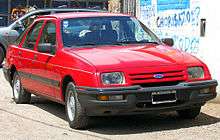
In Argentina, the Sierra was offered as a five-door hatchback beginning in the summer of 1984.[38] A station wagon body style was added in September 1985.[39] The sporting XR4, with three-door bodywork arrived a couple of months after the original introduction. The facelifted post-1987 model did not reach the Argentinian market, where the range continued with a Merkur XR4Ti-like grille until 1991 for XR4 and 1992 for five-door models, when it was replaced by the Volkswagen Santana-based Galaxy.[40] Argentinian Sierras can be distinguished by a more sculpted front bumper with an extra cooling inlet.
The 1.6L was offered in GL model only, while the LX, Ghia, Ghia S/SX and XR4 were available with a 2.3-litre inline-four with some differences in specs. Both engines, as for the preceding Taunus TC3, were from the "Pinto" family. The power ranged between 75 PS (55 kW) for the 1.6 and 120 PS (88 kW) for the XR4 and later Ghia S versions.[39] Some Ghia models also featured automatic transmission as an optional. The station wagon was called the Sierra Rural.[41] Ford had previously used the name "Rural" for station wagons in Argentina, such as the Taunus, in a similar way to "Turnier" in Germany.[42]
The GL model was the base model replaced by the LX with the same equipment. The XR4 was eventually complemented by the five-door Ghia S/SX.
Venezuela
In Venezuela the locally assembled Ford Sierra was launched in 1985, the 2.8L V6 engine being standard on versions sold there, including the 5 door hatchback (280 LS and 280ES) and 3 door hatchback (280 LS and 280GT)[43] as well as the 5 door station wagon (Ranchera).[44] In 1990, a face-lifted version of the Sierra, powered by the 2.9L V6 engine was offered as both a hatchback and a sedan, the latter being known as the Sierra 300 Sapphire, although unlike the Sapphire in other markets, it had a blanked-off grille.[45] Also launched in Venezuela was the XR6i.[46]
North America
In North America, the Ford Sierra and the Ford Scorpio were offered under the now defunct Merkur brand. The Sierra was imported as a three-door only, and called the XR4Ti (similar to sub-model designations in other markets). The Sierra name was not used by Ford in North America; the market had already seen the similar-sounding Oldsmobile Ciera, and the Sierra name was used and trademarked by General Motors Corporation from the 1970s as a trim level on its pickup trucks.
The car was offered from the start of the Merkur brand in 1985 until 1989. It was equipped as a rear-wheel-drive 2.3-litre SOHC inline 4-cylinder (commonly known as the "Lima" engine) equipped with a Garrett T3 turbocharger and fuel injection.
Although offering the top-selling XR model worldwide, the Merkur brand is claimed to have been a commercial flop. The reasons vary. Safety and emissions regulations in the U.S. forced Ford to make costly modifications, resulting in relatively high prices, coupled with the required addition of air bags for all 1990 and newer vehicles (not required in foreign markets) doomed the mark to an untimely end. Exchange rates also fluctuated too frequently. Moreover, since Merkurs were sold at Lincoln–Mercury dealers, many customers were more attracted towards Mercury models, such as the Mercury Sable, which were similarly styled and had similar equipment for significantly lower prices.
Mechanicals
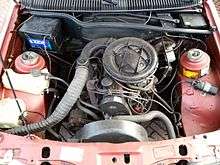
.jpg)
Unlike many of its rivals, the Sierra retained rear-wheel drive, albeit with a modern, fully independent rear suspension, departing from the Cortina's live axle.
In the beginning the Sierra used engines and transmissions from the Taunus / Cortina. The engines were of two types, the SOHC Ford Pinto engine in 1.3, 1.6, 1.8 and 2.0-litre displacements, and the OHV Cologne V6 engine (in 2.0, 2.3, 2.8, and 2.9-litre capacities). Towards the end of the 1980s due to tightening emission standards, the Pinto engine began to be phased out-the 1.8-litre in 1988 replaced by a 1.8-litre CVH, the 2.0-litre in 1989, replaced with the Ford I4 DOHC engine and the 1.6 in 1992, replaced by the 1.6 CVH first seen in the Escort in 1980, described as a "CFi", a single point fuel injection system with a catalytic converter. The 2.9 L Cologne engine was available in the Sierra XR4x4 and the Sierra Ghia. Models with the 2.0 L and Cologne V6 engines had an option of a limited slip differential. Models built until 1989 used the type 9 gearbox that had been used in the Cortina, with the exception of 2WD Cosworth models that used the T5. The T5 had several variations, most were internal. This was basically the same transmission used in the Ford Mustang. The .80 overdrive gears were the weak link. It was later superseded by the MT75 unit (for DOHC, 4X4 and V6 models). All Sierras had rear drum brakes, except sporting models (2.0iS (some), 2.0 GLX & GLS, XR4x4, Sierra Cosworth, other special/sporting models inc 2.0i 4x4) and models with anti-lock brakes. American versions meanwhile were sold only with a 2.3 L four-cylinder turbocharged version of the Pinto engine.
The Sierra also had a diesel option on the engine, namely at launch the 2.3 L normally aspirated 67 PS (49 kW; 66 hp) Indenor diesel made by Peugeot. This engine was also used in contemporary Granadas and whilst reliable and economical it made an unrefined, noisy and very slow vehicle, but remained a popular option for Taxi firms. This was later superseded in 1990 by a 1.8 L turbocharged powerplant of Ford's own design which offered better response times and slightly more power. During the Sierra's production run the engine was known both as the Lynx and as the Endura-D, though was further rebranded as the 'Endura-DE' with the release of the second-generation Ford Mondeo.[47]
Special edition models
.jpg)
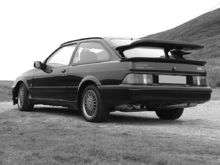
In 1983, the high-performance XR4i version was introduced. It utilised the same 2.8 L Cologne engine as used in the Ford Capri 2.8 Injection of that era and sported a restyled version of the 3-door Sierra bodyshell. The double rear spoiler and curious multi-pillared rear windows were considered over-styled by some prospective buyers, and the car never achieved the cult status of the smaller Fiesta XR2 and Escort XR3i. A version of the XR4i with a 2.3 L turbocharged engine was sold in the United States as the Merkur XR4Ti. The XR4Ti was raced in Europe, most notably by Andy Rouse who used one to win the 1985 BTCC.

In South Africa, there was a 3.0 L V6 version, called the XR6, also made in South Africa was a limited run of 250 V8 XR8s for saloon car racing homologation in 1984. These were based on the Ford Windsor 302 engine.
In 1985 the XR4i was replaced by the XR4x4, which was based on the five-door hatchback, had four-wheel drive and was powered by the same 2.8 L V6 engine but wasn't equipped with the bi-plane rear spoiler. Only a very limited number of three-door XR4x4's have been built. By the end of its production in 1990, 23,540 had been produced. From 1990 to 1993 the XR4x4 was available with both the revised 2.9 EFi and 2.0 DOHC EFi engines. The XR4i also made a reappearance (as a badging exercise) in 5-door form but with the DOHC 2.0 engine instead of the V6.
In 1989, Ford nodded towards its past and created the Sierra 2.0i 2000E, a model name used with limited success on the Mk3 Cortina. The Sierra 2000E had two-tone metallic paint, alloys, light grey leather interior, and a trip computer in addition the standard features on the 'Ghia' models. It was only available in saloon form and a limited number of models were sold between 1989 and 1991. Ford used this to showcase the new DOHC twin cam engine which was also released in 1989.
In Argentina the non-injected XR4 model was equipped with the Taunus 2.3 engine and was produced between 1986 and 1991. In this market the most direct rival was the Renault Fuego 2.2.
In July 1986, a special version called the Ford Sierra RS Cosworth was launched, using the 2.0 OHC bottom end with a 16V DOHC cylinder head specially developed by Cosworth. With the Cosworth Garret T3 turbocharger and intercooler setup the engine produced 204 PS (150 kW; 201 hp). It was designed by Ford's Special Vehicle Engineering (SVE) group and made in Ford's Genk factory in Belgium for use in group A. It was based on a three-door Sierra with the dashboard from the Merkur XR4Ti. The car was available in only white, black or Ford's 'Moonstone Blue' and only 5545 were made. The Sierra RS Cosworth was available in both right hand drive and left hand drive, the RS500 was only produced in Right Hand Drive. Racing conversion were done with the European Merkur dashboard.
In 1987, a 225 PS (165 kW; 222 hp) Sierra Cosworth, the RS500, was sold alongside the regular version. Only 500 were produced as the minimum number of road-going cars required to meet with newly introduced homologation racing rules, allowing it to compete in evolution form for group A racing. The car was modified by the Tickford Engineering Company in conjunction with Ford. Revisions included uprated brakes and larger brake cooling ducts and modified front and rear spoilers (a second smaller rear spoiler was added beneath the large "whale-tail"), a modified front bumper to allow extra cooling for a larger intercooler, as well as various engine upgrades including a larger turbocharger and a second fuel rail (which did not operate on road models). Race outputs were as high as 550 bhp (410 kW; 558 PS), in which the Sierra dominated group A series around the world.
Racing versions of the Cosworth were highly successful in European and World Touring Car racing throughout the late 1980s and early 1990s, and the RS500 helped Ford to win the manufacturer's title in the 1987 World Touring Car Championship. Ford was forced to fall back on the Sierra for rallying from 1987, after the banning of the Group B formula. With only rear-drive, the Sierra struggled to compete on looser surfaces but was very quick on asphalt, Didier Auriol winning his first World Championship rally in a Sierra in Corsica, 1988. It was replaced by the 4x4 Sapphire version from 1990, which never managed to win a World Championship event but became a popular and successful car in national championships. The Sierra was replaced by the Escort Cosworth in 1993.
In 1988, a new Cosworth was produced which was based on the Sierra Sapphire saloon. 13,140 were produced until it was replaced in 1990 by a four-wheel-drive version, the Sierra Sapphire RS Cosworth 4x4, of which 12,250 were built. Its replacement came in the form of the Escort RS Cosworth which appeared in 1992, which used a shortened and developed version of the Sierra platform and running gear but clothed with an Escort-esque bodyshell and the return of the whale-tail spoiler.
Turbocharged versions
Turbocharged versions of the Sierra were also available as post-production models from companies like Janspeed and, most notably, from Turbo Technics. The XR4x4 2.8 was available with a range of aftermarket kits pushing power from 150 PS (110 kW; 148 hp) to over 200 hp (149 kW). The 2.9 got a twin-turbo setup, available with variants up to 280 hp (209 kW). Even the DOHC version got a single turbo kit, of which only a small number were made. Turbo Technics even sold their own pre-prepared Sierra known as the Minker; only a handful were ever produced, as they cost significantly more than Ford's own RS Cosworth.
In Finland, tax laws made the 1.3 L and 1.6 L-engined Sierras attractive business cars in the mid 1980s. Beginning in 1982, a number of these smaller engines were turbocharged locally in order to gain 2.0 L engine power without moving into the higher tax bracket. The 2.0 L OHC engine was also available turbocharged. These are often called "Stockmann Turbo" Sierras, after the provider of the most popular conversion kits.[48] After stricter emissions standards were introduced for 1989, Stockmann focused on getting the more popular 1.6-litre kit approved and stopped offering the other ones. They were not intended as sporting cars, but were "tax specials" meant to save owners money without sacrificing power. The purchase price of a 1.6 Turbo was marginally higher than that of a factory 2.0, but the difference was quickly made up in tax savings.[48]
Changes during production life
.jpg)
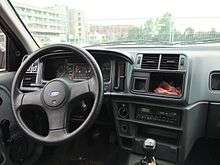
After the major facelift of 1987, and the introduction of the DOHC engines in 1989, further changes to the Sierra were superficial. Some detail styling changes were made in 1990, when the dashboard styling was freshened up, the front was given clear-lensed indicators, the rear given smoked rear lamp lenses, the steering wheel redesigned and a new front grille was added, together with fuel injection as standard, 15-inch wheels and rear disc brakes. UK production of the Sierra ceased in 1990 with right hand drive production moving to Belgium.
For the 1991 model year, the 1.6 litre Pinto engine was finally dropped and replaced by a CVH unit of similar capacity, marking the end of the venerable Pinto unit after it had been introduced in the Cortina/Taunus some 21 years earlier. The 1992 model year cars saw the final revisions - most notably the dashboard which gained a more rounded instrument binnacle similar in style to the 1990 Escort and Orion, along with specification, colour and trim upgrades across the whole range.
By 1989, Ford had confirmed that the successor to the Sierra (due by 1993) would feature front-wheel drive, and a number of concept cars were shown in the motoring press, hinting at what the new car might look like. By the early 1990s it had become clear that the Sierra had fallen out of step technologically against modern Japanese rivals which offered multi-valve engines and multi-link rear suspension. All of these features appeared on the Sierra's replacement, the front-wheel-drive Mondeo, which was unveiled in November 1992 and went on sale the following March.
Popularity
The Sierra is the tenth-most popular car to have been sold in Britain, with 1,299,993 units having been sold.[49] The first Sierras were sold in October 1982, and stocks lasted for around two years after the end of production - with more than 200 models being sold in 1994 and at least one example being sold in 1995 (in February as an M-registered model).
The Sierra remained a common sight on the roads in the United Kingdom and several other European countries, and a popular second-hand buy, until well into the 21st century. However, just 2,425 Ford Sierras were reported to be taxed and still on UK roads in December 2019, with 11,562 currently SORN.[50][51]
References
- "Facilities | Ford Motor Company Newsroom". Media.ford.com. Archived from the original on 2010-09-02. Retrieved 2010-09-18.
- "HIGHLIGHTS OF FORD NEW ZEALAND; Ford Motor Company Newsroom". Media.ford.com. Archived from the original on 2013-07-12. Retrieved 2010-09-18.
- Ford Sierra, The Independent, 6 November 2007
- "Road test". Retrieved 2011-06-18.
- "Insider Dealing". Autocar & Motor. Vol. 213. Haymarket Motoring Publications. 1997-08-06. p. 13.
- "Ford Sierra". The Independent. November 6, 2007.
- Sundfeldt, Björn (1982-09-22). "Ford Sierra: Futurism som fungerar" [Functioning futurism]. Teknikens Värld (in Swedish). Vol. 34 no. 20. Stockholm, Sweden: Specialtidningsförlaget AB. p. 22.
- Fisher, Brian (1983-03-10). "Lotus, R-R & Co". Le Moniteur de l'Automobile (in French). Brussels, Belgium: Editions Auto-Magazine. 34 (764): 28.
- Elphick, Andrew; Humble, Mike; Loveridge, Warren (2013-09-17). "The cars: Ford Sierra development story". AROnline.
- "The salesman's spaceship that saw into future". The Scotsman. 4 August 2006.
- Linger, Heinrich (5 February 2015). "Auto, Motor und Sport
Lade der Nation: Deutschland ist ein KombiLand, rund 20 Prozent aller verkauften Autos gehoeren zu dieser Kategorie. Also tritt der neue Ford Mondeo als Kombi gegen den Bestseller in der Kombi-Mittelklasse an, den VW Passat. Wer bietet mehr, Turnier oder Variant?". Mention of the 1982 Sierra/Passat comparison road-test re-surfaced in a February 2015 comparison test involving diesel station wagon ("Turnier"/"Variant") versions of the Ford Mondeo and the Volkswagen Passat. In 2015 the Passat "won". Motor Presse Stuttgart. 04/2015: 46. - "Previous winners". Car of the year. Archived from the original on 2010-09-14. Retrieved 2010-09-18.
- Kinnock says seatbely saved his life in motorway crash, The Glasgow Herald, July 14, 1983
- Ford Car Plant to Close 1984, RTÉ Archives
- Sloniger, Jerry (1985-03-19). "Poikkeava nelivetoinen" [Unusual four-wheel drive]. Tekniikan Maailma (in Finnish). Vol. 41 no. 5/85. Helsinki: TM-Julkaisu. p. 32. ISSN 0355-4287.
- Pagani, Pierre (April 1985). "Ford Sierra XR "4x4"". Echappement (in French). Paris, France: Michael Hommell (198): 68.
- Büschi, Hans-Ulrich, ed. (6 March 1986), Automobil Revue 1986 (in German and French), 81, Berne, Switzerland: Hallwag AG, p. 294, ISBN 3-444-00450-8
- Lawrence, Mike (August 1986). "Ford Sierra Ghia 4x4 Estate". Motor Sport. Vol. LXII no. 8. p. 17.
- Automobil Revue 1986, p. 103
- 1984 Ford Sierra Van (brochure) (in Dutch), Ford Nederland B.V., p. 2
- 1984 Ford Sierra Van, p. 2
- "sierra vans, £500 each. Ireland | Retro Rides". forum.retro-rides.org.
- Büschi, Hans-Ulrich, ed. (7 March 1985), Automobil Revue 1985 (in German and French), 80, Berne, Switzerland: Hallwag, AG, p. 245, ISBN 3-444-06081-5
- Automobil Revue 1985, p. 247
- Mastrostefano, Raffaele, ed. (1985). Quattroruote: Tutte le Auto del Mondo 1985 (in Italian). Milano: Editoriale Domus S.p.A. p. 430. ISBN 88-7212-012-8.
- Ford Sierra 2.0 liter
- Ford Sierra station wagon, 3ltr, GLX V6
- International Motor Business, Issues 137-140, Economist Intelligence Unit, 1989, page 59
- 1989 Ford Sapphire
- "Ford Sierra XR6 ad (1984)". November 29, 2010 – via YouTube.
- "Sierra XR8". www.africanmusclecars.com. Retrieved 16 December 2013.
- Tutte le Auto del Mondo 1985, p. 434
- "1990 MAZDA 626 2.0 M/T Auto For Sale On Auto Trader South Africa". April 16, 2015 – via YouTube.
- Anderson, Donn (June 1984). "Time for Kiwi Sierras". Wheels. Sydney, Australia: Murray Publishers: 20.
- The Motor, Volume 168, Temple Press Limited, 1985, page 32
- Great moments in security, The Sydney Morning Herald, July 9, 1984
- "the Persuader Blog: The missing wagon". Jack Yan. 2006-10-15. Retrieved 2009-05-09.
- American Business in Argentina Directory, American Chamber of Commerce in Argentina, 1984, page 19
- Büschi, Hans-Ulrich, ed. (9 March 1989). Automobil Revue 1989 (in German and French). 84. Berne, Switzerland: Hallwag AG. pp. 298–299. ISBN 3-444-00482-6.
- The motor industries of South America and Mexico: poised for growth, Marco Piquini, Economist Intelligence Unit, 1995, page 185
- Anuário ADEFA, Asociación de Fábricas de Automotores, 2000, page 105
- La Ley, Volume 123, 1966, page 528
- World Motor Vehicle Data, American Automobile Manufacturers Association, 1988, page 376
- "Ford Sierra 1985 de Venezuela.wmv". June 5, 2011 – via YouTube.
- "Ford Sierra 300 Sapphire - comercial 1990 - Venezuela". April 4, 2009 – via YouTube.
- "Ford Sierra XR6i 1988-89 Venezuela.wmv". June 5, 2011 – via YouTube.
- "Crustworld - Ford Sierra Online". www.crustworld.co.uk.
- Vaatola, Tapani (November 1989). "Ford Sierra 1.6 Turbo - kotimainen veroviritys" [Home grown tax evasion]. Tuulilasi (in Finnish).
- "icLiverpool - Recession-proof wise-buys revealed". Icliverpool.icnetwork.co.uk. 2009-03-17. Archived from the original on 2009-04-27. Retrieved 2010-09-18.
- "100 popular cars vanishing from our roads". www.msn.com.
- {{cite web|url=https://classics.honestjohn.co.uk/how-many-survived/ford/sierra